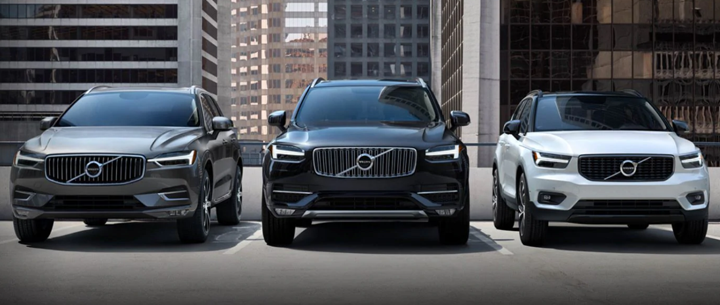While safety is a top-of-mind fleet concern, America’s roads continue to be a hazardous place to do business.
After falling over the past several decades, collision rates — including fatalities — have ticked up. Recent statistics from the National Safety Council (NSC) show that there was a 14% increase in fatalities year over year even though miles driven have decreased during the same period1.
This demonstrates that even with a strong safety program in place, fleet drivers as still at risk to be in a serious collision — often due to the poor driving habits of other drivers.
A Safe Answer
Power, efficiency, and, most importantly, safety extend to the entire Volvo lineup.
For sales and company executives, the S 60 sedan is available with two gasoline and two gasoline/hybrid engines delivering from 250 to 415 HP. The S 90 is available with an all-wheel-drive gasoline engine that generates 316 HP.
For fleets that want a vehicle that offers the style of a sedan with the practicality of an SUV, there is the V 60 and V 90 wagon. The V 60 is available with a front-wheel-drive turbocharged gasoline engine, which produces 250 HP. The V 60 CC is equipped with an all-wheel-drive turbocharged gasoline engine, which all also produces 250 HP. The V 90 is available with two gasoline engines that produce from 197 to 250 HP, or two diesel engines that produce from 197 to 235 HP. The V 90 CC is available with an all-wheel-drive gasoline engine that produces 316 HP.
Volvo’s PHEV SUV lineup, including the XC 40, XC 60, and XC 90, provides fleets with kind of power and capacity that’s designed to meet most business demands. The compact XC 40 is available with two gasoline-powered engines and one electric powerplant generating 187, 248, and 402 HP respectively. The XC 60 is available with a variety of gasoline and hybrid-electric powerplants with an output of 250 HP for T5 FWD to 415 HP for the Polestar Engineered gasoline/hybrid engine. The XC 90 has three available gasoline-powered engines and a gasoline/electric hybrid powerplant, which deliver from 250 to 400 HP.
While this power will allow drivers to get their work done efficiently, the entire Volvo lineup is designed first and foremost with safety in mind. To this end the entire Volvo lineup — SUVs and sedans — include a wide array of standard safety features regardless of trim level, including:
- Laminated windscreen and safety cage
- Defroster vents for windscreen
- Three-point seat belt
- Crumple zones
- Reminder for safety belts
- Rearward-facing child safety seat
- Lambda sensor
- Child safety booster cushion
- Side Impact Protection System (SIPS)
- Rollover Protection Structure (ROPS)
- Inflatable Curtain
- Whiplash Protection System (WHIPS)
- Collison warning with brake support
- Driver Alert
- City Safety
- Pedestrian Detection with autobrake
- Cyclist Detection with autobrake
- In-car delivery
- Cross-traffic Alert
- Lane-keeping aid
- Oncoming lane mitigation
- Run-off road mitigation
But safety extends even further. Recognizing that speeding — which is tied to driver behavior — is a one weak links in the safety chain along with distracted driving, from 2020, all Volvo vehicles will have a top speed of 112 mph.
Further, built-in geofencing technology will automatically limit the vehicle’s speed to posted limits around schools and hospitals.
To this end, fleets won’t have to sacrifice safety based on trim or pricing limits for drivers. That means drivers across the board from the entry-level driver employee to the top executive will experience the same level of safety and protection while driving.
A Safe Business Choice
With the ongoing pressure on fleets and business in general to cut costs and increase efficiency, fleets need to make every dollar count. A Volvo SUV or sedan may have higher up-front initial cost than some fleets are used to, but consider it an investment in safety — both to protect your drivers and, just as important, to protect your company’s bottom line.
Collision costs can add up fast. A bent-metal only crash drains a fleet’s company coffers of almost $15,000 on average. When there’s an injury involved—that cost will increase more than four fold. Worker’s compensation claims alone for injured drivers are about $70,000 or twice a typical office-related injury2. And worst of all, fatality crash costs not only a human life but will likely result in the company owing millions in ruinous direct liability costs not to mention significant damage to the brand in the court of public opinion.
With fewer crashes due to a significant number of collision avoidance and mitigation technologies, your company will be able to save on maintenance and personnel costs — decreasing non-productive downtime — while increasing driver productivity and the bottom line.
And the bottom line is this: Volvo is the safe vehicle choice for commercial fleets.
To find out more how you can better protect your drivers and the company’s bottom line go to Volvo’s Fleet Sales Website.
References
1. Road Fatalities Up in March Despite Drop in Miles Driven, NSC Study Finds
2. Commercial Fleet Accident Rate Reaches 20%
by Volvo Commercial Sales
Source: https://www.automotive-fleet.com
CUT COTS OF THE FLEET WITH OUR AUDIT PROGRAM
The audit is a key tool to know the overall status and provide the analysis, the assessment, the advice, the suggestions and the actions to take in order to cut costs and increase the efficiency and efficacy of the fleet. We propose the following fleet management audit.




